 W
WAlcolapia alcalica, the common Natron tilapia or soda cichlid, is an endangered species of fish in the family Cichlidae. It is endemic to the hypersaline, warm Lake Natron, its drainage and the Shombole Swamps in Kenya and Tanzania. This species typically has an essentially terminal (straight) mouth, but a morph with an upturned mouth is found locally in eastern Lake Natron, where it co-occurs with the normal morph. A. latilabris and A. ndalalani, the two other species in Lake Natron, both have a clearly downturned mouth. Territorial males of A. alcalica have extensive blue-white spotting, and their underparts and throat can be yellow or white. Females and non-territorial males are overall sandy in colour. A. alcalica reaches up to 11.6 cm (4.6 in) in total length.
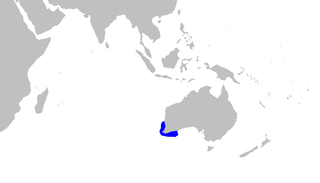 W
WThe Australian blackspotted catshark is a catshark of the family Scyliorhinidae in the order Carcharhiniformes. It is endemic to Western Australia in the eastern Indian Ocean between latitudes 28° S and 36° S. It can grow up to 67 cm.
 W
WBarbus ksibi is a doubtfully distinct ray-finned fish species in the family Cyprinidae. It is found only in Morocco.
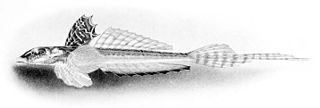 W
WCallionymus caeruleonotatus, the Blue-spotted dragonet, is a species of dragonet endemic to the waters around the Hawaiian Islands where it occurs at depths of from 42 to 325 metres. This species grows to a length of 5.4 centimetres (2.1 in) SL.
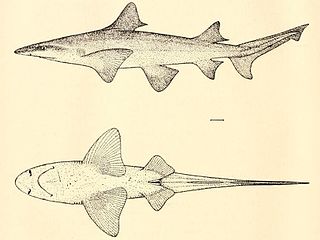 W
WThe Borneo broadfin shark is a species of requiem shark, and part of the family Carcharhinidae.
 W
WBoutan's whiting, Sillago boutani, is a poorly understood species of coastal marine fish of the smelt-whiting family Sillaginidae that inhabits the waters of the Gulf of Tonkin and south eastern China. Like most sillaginids, the species inhabits areas populated with a number of other whiting species of similar appearance, causing the species to often be misidentified as the well known Sillago sihama, and for this reason its biology is poorly known. The species is taken by seine net in Vietnam and is often exported to Japan.
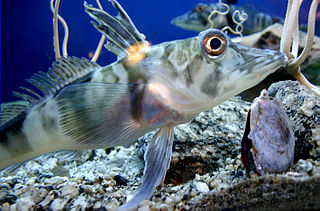 W
WThe Chionodraco hamatus is a fish in the family Channichthyidae, the "crocodile icefish".
 W
WCallionymus decoratus, the Decorated dragonet, is a species of dragonet endemic to the waters around the Hawaiian Islands where it occurs at depths of from 1 to 134 metres. This species grows to a length of 20.8 centimetres (8.2 in) SL.
 W
WThe deepbody bitterling or Itasenpara bitterling is a species of freshwater fish in the family of Cyprinidae. It is endemic to central and southern Japan. It grows to a maximum length of 8.0 cm.
 W
WDysalotus alcocki is a species of deep sea fish, a swallower, from the family Chiasmodontidae which is found in the tropical and temperate oceans around the world. The adults fed mainly on fish. The juveniles and larvae are most frequently recorded from shallower waters while adults are mostly caught from depths of over 1,000 metres (3,300 ft). The generic name is derived from the Greek dysalotos which means "difficult to catch" and the specific name honours the English zoologist Alfred William Alcock (1859-1933).
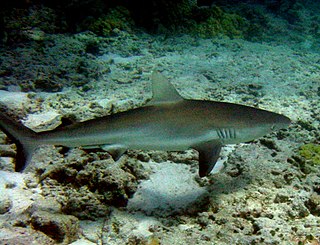 W
WThe Galapagos shark is a species of requiem shark, in the family Carcharhinidae, found worldwide. It favors clear reef environments around oceanic islands, where it is often the most abundant shark species. A large species that often reaches 3.0 m (9.8 ft), the Galapagos reef shark has a typical fusiform "reef shark" shape and is very difficult to distinguish from the dusky shark and the grey reef shark. An identifying character of this species is its tall first dorsal fin, which has a slightly rounded tip and originates over the rear tips of the pectoral fins.
 W
WThe goldeneye cichlid is a species of cichlid found in fresh water from the Aruka River in Guyana, to the Maroni River in Surinam. It is often found on flooded savannas near the coast. The male grows to a length of about 5.6 centimetres (2.2 in) while the female is somewhat smaller, and is thus regarded as a dwarf cichlid.
 W
WThe Hawaiian lanternshark is a shark of the family Etmopteridae found around the Hawaiian Islands, between latitudes 23°N and 19°N, at depths between 400 and 910 m. Its maximum length is at least 46 cm.
 W
WThe Hawaiian sea-moth fish is a species of fish in the family Pegasidae. It is endemic to Hawaii.
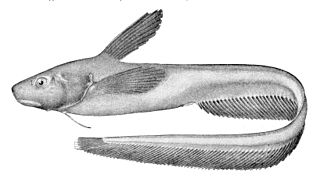 W
WIjimaia plicatellus is a species of jellynose fish in the family Ateleopodidae. Their distribution is in the Eastern Central Pacific near Hawaii. They live at depths from 265 to 500 meters, and reach up to 68 cm in length.
 W
WJordan's chimaera is a species of fish in the family Chimaeridae found near Japan, Madagascar, and Mozambique. Its natural habitat is open seas.
 W
WThe mackerel icefish is a benthopelagic fish found in the Southern Ocean and southernmost Atlantic Ocean. They are mainly to be found near Heard and McDonald Islands, Îles Kerguelen and islands in the south Atlantic such as South Georgia and Bouvet Island at depths of 0–700 metres (0–2,297 ft), but are commonly found at depths of 30 to 250 metres.
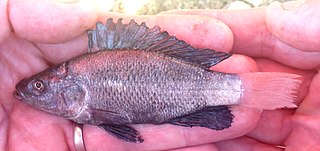 W
WOreochromis amphimelas is a species of tilapia cichlid endemic to north–central Tanzania, where it is found in Lake Manyara and a number of other saline lakes with closed basins. Maximum recorded size is 28 cm (11 in) in standard length.
 W
WOryzias sarasinorum, the Sarasins minnow or Sarasins buntingi, is a species of ricefish in the Adrianichthyidae. It is endemic to Lake Lindu in Lore Lindu National Park, Sulawesi, Indonesia. This species was described as Haplochilus sarasinorum by C.M.L. Popta in 1905 and she named it in honour of the Swiss naturalists and second cousins Paul Sarasin (1856-1929) and Fritz Sarasin (1859-1942), the latter being the collector of the type. Although the IUCN state that the population of this fish is stabled it is threatened by introduced non native fish, common carp, Mozambique tilapia and walking catfish; and a decline in water quality caused by increased agriculture in the lake's catchment which is causing a decline in water quality, it is therefore assessed as Critically Endangered.
 W
WThe painted notie is a species of notothen native to the Southern Ocean, ranging east from southern South America to south of the central Indian Ocean, where it lives on the seabed at depths from 30 to 750 m. This species can reach a total length of 24 cm (9.4 in). The painted notie eats krill, mysids and hyperiid amphipods. This species spawns in autumn and winter.
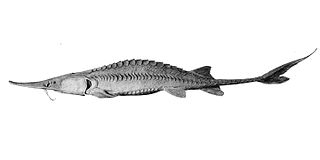 W
WThe pallid sturgeon is an endangered species of ray-finned fish, endemic to the waters of the Missouri and lower Mississippi river basins of the United States.
 W
WParapercis snyderi, commonly known as Snyder's grubfish or U-mark sandperch, is a marine fish native to the waters off northern Australia and Indonesia. The specific name honours the ichthyologist John Otterbein Snyder who collected the type specimen with David Starr Jordan, one of the co-describers of the species, at Nagasaki.
 W
WPolyipnus nuttingi, commonly known as the Nutting's hatchet fish, is a species of ray-finned fish in the family Sternoptychidae. It occurs in deep water in the Indo-Pacific Ocean, at depths between about 384 and 658 metres.
 W
WThe purple chimaera or purple ghostshark is a species of fish in the family Chimaeridae found off Japan and Hawaii. Its natural habitat is open seas.
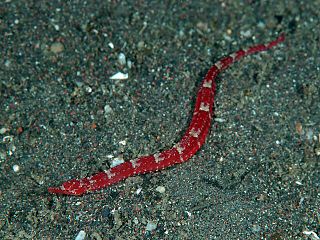 W
WThe red pipefish is a species of marine pipefish of the family Syngnathidae. It is found throughout the Indo-Pacific, from Mozambique and South Africa to Hawaii, Honshu (Japan), and New Caledonia. It lives among rubble and coral or rocky reefs at depths of 18–40 metres (59–131 ft), where they can grow to lengths of 10 centimetres (3.9 in). They are expected to feed on small crustaceans, such as gammarid shrimps, mysids, and harpacticoid copepods. This species is ovoviviparous, with males brooding eggs and giving birth to live young. Males may brood at lengths of around 5.5 centimetres (2.2 in). It is exported from Hawaii as part of the aquarium trade.
 W
WSnyderidia canina is a species of pearlfish found in all tropical waters but those of the eastern Pacific Ocean, depths from 110 to 1,762 m. This species grows to a length of 26.8 cm (10.6 in). This fish is the only known species in its genus which was named in honour of the ichthyologist John Otterbein Snyder (1867-1943) for the assistance he lent to Charles Henry Gilbert on the cruise to Hawaii on which the type specimen was collected.
 W
WThe spongehead catshark is a rare species of deep-sea catshark, family Scyliorhinidae. This species was only known from two specimens taken in the Pacific Ocean: an adult from near Bird Island, Hawaii, and a juvenile from the Banda Sea off Sulawesi. They are found on or near the bottoms of insular continental slopes, at depths of 570 to 1,480 meters. In 2002, the spongehead catshark was seen alive in its natural habitat for the first time, from the submersible Pisces IV at a depth of about a kilometer, on the Northampton Seamount off the northwestern Hawaiian Islands.
 W
WStemonidium hypomelas is a species of deep-sea eel in the family Serrivomeridae, originally described from a 171-mm specimen taken from a depth of around 1,000 m near Niihau Island, Hawaii in 1902. It can be distinguished from the related sawtooth eels by its reduced dentition, which more resemble those of the snipe eel. It is of no significance to fisheries.
 W
WStethopristes eos is a species of parazen found in the Pacific Ocean where it has so far only been recorded from near Chile and near Hawaii. It is known from depths of from 343 to 686 metres. This species is the only known member of its genus.
 W
WSynchiropus rubrovinctus, the tiny Hawaiian dragonet, is a species of dragonet native to the western Pacific where it has been found around Japan, New Caledonia and Hawaii. This species occurs at depths of from 1 to 79 metres. This species reaches a length of 2.4 centimetres (0.94 in) TL.
 W
WSynodontis nigromaculatus, known as the spotted squeaker, the blackspotted squeaker, or the speckled squeaker, is a species of upside-down catfish that is found widely in southern Africa. It has been identified in Angola, Botswana, the Democratic Republic of the Congo, Mozambique, Namibia, South Africa, Zambia, and Zimbabwe. It was first described by British-Belgian zoologist George Albert Boulenger in 1905, from specimens collected in Lake Bangweulu in Zambia.
 W
WVieja maculicauda also known as the blackbelt cichlid, is a cichlid fish species native to Central America from Southern Mexico to Panama.
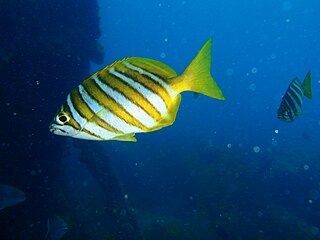 W
WThe western footballer, also known as the footballer sweep, is a species of sea chub endemic to southern reefs of Australia, where it can be found down to 30 m (98 ft). It can also be found in the aquarium trade. This species is currently the only known member of its genus.
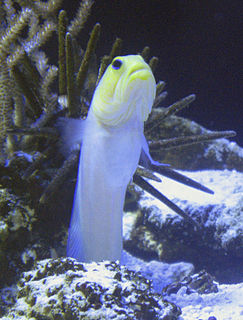 W
WThe yellowhead jawfish is a species of jawfish native to coral reefs in the Caribbean Sea. It is found at depths of from 3 to 40 metres. The head and upper body are a light, but brilliant, yellow color slowly fading to a pearlescent blue hue. It can reach a length of 10 centimetres (3.9 in) TL. Yellowhead jawfishes are usually found in Florida. They are usually found in shallow areas where materials are available for burrow construction. The Jawfishes live in rubble areas and sand in groups of up to 70 species.
 W
WZoramia gilberti is a Cardinalfish from the Western Central Pacific. It occasionally makes its way into the aquarium trade. It grows to a size of 4.2 cm in length. It is found in sheltered bays and lagoons, where it gathers in large aggregations among branching corals, frequently mixed with other cardinalfish species. The specific name honours the American ichthyologist and fisheries biologist Charles H. Gilbert (1859-1928) of Stanford University who was a colleague of Jordan's.